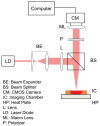Optical Thromboelastography to evaluate whole blood coagulation
- PMID: 24700701
- PMCID: PMC4605542
- DOI: 10.1002/jbio.201300197
Optical Thromboelastography to evaluate whole blood coagulation
Abstract
Measurement of blood viscoelasticity during clotting provides a direct metric of haemostatic conditions. Therefore, technologies that quantify blood viscoelasticity at the point-of-care are invaluable for diagnosing coagulopathies. We present a new approach, Optical Thromboelastography (OTEG) that measures the viscoelastic properties of coagulating blood by evaluating temporal laser speckle fluctuations, reflected from a few blood drops. During coagulation, platelet-fibrin clot formation restricts the mean square displacements (MSD) of scatterers and decelerates speckle fluctuations. Cross-correlation analysis of speckle frames provides the speckle intensity temporal autocorrelation, g2 (t), from which MSD is deduced and the viscoelastic modulus of blood is estimated. Our results demonstrate a close correspondence between blood viscoelasticity evaluated by OTEG and mechanical rheometry. Spatio-temporal speckle analyses yield 2-dimensional maps of clot viscoelasticity, enabling the identification of micro-clot formation at distinct rates in normal and coagulopathic specimens. These findings confirm the unique capability of OTEG for the rapid evaluation of patients' coagulation status and highlight the potential for point-of-care use.
Keywords: Blood; coagulation; laser speckle; optical thromboelastography; rheology; thromboelastography; viscoelasticity.
© 2014 WILEY-VCH Verlag GmbH & Co. KGaA, Weinheim.
Figures





Similar articles
-
Evaluation of Blood Coagulation by Optical Vortex Tracking.Sensors (Basel). 2022 Jun 24;22(13):4793. doi: 10.3390/s22134793. Sensors (Basel). 2022. PMID: 35808290 Free PMC article.
-
Comprehensive Coagulation Profiling at the Point-of-Care Using a Novel Laser-Based Approach.Semin Thromb Hemost. 2019 Apr;45(3):264-274. doi: 10.1055/s-0039-1683842. Epub 2019 Mar 18. Semin Thromb Hemost. 2019. PMID: 30887486 Free PMC article.
-
Optical sensing of anticoagulation status: Towards point-of-care coagulation testing.PLoS One. 2017 Aug 3;12(8):e0182491. doi: 10.1371/journal.pone.0182491. eCollection 2017. PLoS One. 2017. PMID: 28771571 Free PMC article.
-
Viscoelasticity and Ultrastructure in Coagulation and Inflammation: Two Diverse Techniques, One Conclusion.Inflammation. 2015 Aug;38(4):1707-26. doi: 10.1007/s10753-015-0148-7. Inflammation. 2015. PMID: 25772112 Review.
-
The utility of thromboelastography in inherited and acquired bleeding disorders.Br J Haematol. 2016 Aug;174(4):503-14. doi: 10.1111/bjh.14148. Epub 2016 Jun 5. Br J Haematol. 2016. PMID: 27264484 Review.
Cited by
-
Optimizing transfusion strategies in damage control resuscitation: current insights.J Blood Med. 2018 Aug 20;9:117-133. doi: 10.2147/JBM.S165394. eCollection 2018. J Blood Med. 2018. PMID: 30154676 Free PMC article. Review.
-
Evaluation of Blood Coagulation by Optical Vortex Tracking.Sensors (Basel). 2022 Jun 24;22(13):4793. doi: 10.3390/s22134793. Sensors (Basel). 2022. PMID: 35808290 Free PMC article.
-
Mapping Mechanical Properties of the Tumor Microenvironment by Laser Speckle Rheological Microscopy.Cancer Res. 2021 Sep 15;81(18):4874-4885. doi: 10.1158/0008-5472.CAN-20-3898. Cancer Res. 2021. PMID: 34526347 Free PMC article.
-
Thromboelastography in the Perioperative Period: A Literature Review.Cureus. 2023 May 23;15(5):e39407. doi: 10.7759/cureus.39407. eCollection 2023 May. Cureus. 2023. PMID: 37362492 Free PMC article. Review.
-
Evaluating platelet aggregation dynamics from laser speckle fluctuations.Biomed Opt Express. 2017 Jun 30;8(7):3502-3515. doi: 10.1364/BOE.8.003502. eCollection 2017 Jul 1. Biomed Opt Express. 2017. PMID: 28717586 Free PMC article.
References
-
- Bern M, McCarthy N. Blood Coagul Fibrinolysis. 2012;24:59–63. - PubMed
-
- Edelman JJ, Reddel CJ, Kritharides L, Bannon PG, Fraser JF, Curnow JL, Vallely MP. J Thorac Cardiovasc Surg. in press.
-
- Whiting D, Dinardo JA. Am J Hematol. 2014;89:228–232. - PubMed
-
- Evans PA, Hawkins K, Lawrence M, Williams RL, Barrow MS, Thirumalai N, Williams PR. Med Eng Phys. 2008;30:671–679. - PubMed
Publication types
MeSH terms
Grants and funding
LinkOut - more resources
Full Text Sources
Other Literature Sources

